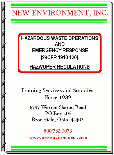Supplemental Student Material
our E-Newsletter

Below you will find the supplemental material that is needed for the training courses that we offer.
OSHA Guidance Manual For Hazardous Waste Site Activities
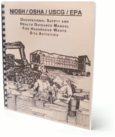
$10.00
This manual is a guidance document for managers responsible for occupational safety and health programs at inactive hazardous waste sites.
It is the product of a four-agency committee (the National Institute for Occupational Safety and Health, the Occupational Safety and Health Administration, the U.S. Coast Guard, and the U.S. Environmental Protection Agency) mandated by CERCLA section 301(f) to study the problem of protecting the safety and health of workers at hazardous waste sites, and by CERCLA section 111(c)(6) to develop a program to protect the health and safety of employees involved in response to hazardous substance releases, removals, or remedial actions.
- As a planning tool by government or private individuals.
- As a management tool by upper level or field managers.
- As an educational tool to provide a comprehensive overview of all aspects of safety and health protection at hazardous waste sites.
- As a reference document for site personnel who need to review important aspects of health and safety.
DOT Emergency Response Guidebook
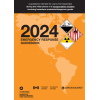
$6.00
This Guidebook is primarily a guide to aid first responders in quickly identifying the specific or generic hazards of the material(s) involved in the incident, and protecting themselves and the general public during the initial response phase of the incident.
The Emergency Response Guidebook is updated every three to four years to accommodate new products and technology.
Use this DOT-issued guidebook to help you satisfy DOT's requirement that Hazmat shipments be accompanied by emergency response information (49 CFR Section 172.600).
- Reviewed the guidebook and changed these sections to make them easier to read and understand
- Added a new decontamination section to describe basic contamination theory and proper decontamination techniques.
- Reworked the BLEVE section into the BLEVE and Heat Induced Tear section. This section now shows the cause and hazards of BLEVEs and Heat Induced Tears.
- Expanded Rail Car Identification Chart and Road Trailer Identification Chart to two pages each.
- Updated Table 1 and Table 3 based on new TIH data and reactivity research.
- Added Lithium battery label and marking, and gasoline placard to the Table of Markings, Labels, and Placards. Added New terms and their definitions to the Glossary.
- Basic information on Improvised Explosive Devices (IED) in the Criminal or Terrorist Use of Chemical, Biological and Radiological Agents section.
- Added A top view illustration of the TC117/DOT117 to the Rail Car Identification Chart.
- Added Illustration of an Intermodal Freight Container to the Road Trailer Identification Chart.
- Improved the illustrations in the Rail Car and Road Trailer Identification Charts.
- Added fifteen new materials (UN3535 to UN3549) listed in the UN Recommendations on the Transport of Dangerous Goods (up to the 21st revised edition).
- Re-evaluated the polymerization hazard criteria for some high-risk materials, and added the polymerization marking (P) to 13 materials
- Re-analyzed the chemical properties of many materials to make sure that they’re assigned to the appropriate Orange Guide. Also moved thirty-four materials to a different Orange Guide.
- Added an introduction called “How to use the Orange Guides”. This new section explains the 4 parts of an Orange Guide. In this section, the terms “evacuate” and “isolate” are defined
Published by the U.S. Department of Transportation. 4"x5.25" Pocket Version
DOT Emergency Response Guidebook - Spiral Bound
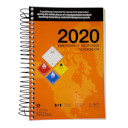
$8.00
This Guidebook is primarily a guide to aid first responders in quickly identifying the specific or generic hazards of the material(s) involved in the incident, and protecting themselves and the general public during the initial response phase of the incident.
The Emergency Response Guidebook is updated every three to four years to accommodate new products and technology.
Use this DOT-issued guidebook to help you satisfy DOT's requirement that Hazmat shipments be accompanied by emergency response information (49 CFR Section 172.600).
- Reviewed the guidebook and changed these sections to make them easier to read and understand
- Added a new decontamination section to describe basic contamination theory and proper decontamination techniques.
- Reworked the BLEVE section into the BLEVE and Heat Induced Tear section. This section now shows the cause and hazards of BLEVEs and Heat Induced Tears.
- Expanded Rail Car Identification Chart and Road Trailer Identification Chart to two pages each.
- Updated Table 1 and Table 3 based on new TIH data and reactivity research.
- Added Lithium battery label and marking, and gasoline placard to the Table of Markings, Labels, and Placards. Added New terms and their definitions to the Glossary.
- Basic information on Improvised Explosive Devices (IED) in the Criminal or Terrorist Use of Chemical, Biological and Radiological Agents section.
- Added A top view illustration of the TC117/DOT117 to the Rail Car Identification Chart.
- Added Illustration of an Intermodal Freight Container to the Road Trailer Identification Chart.
- Improved the illustrations in the Rail Car and Road Trailer Identification Charts.
- Added fifteen new materials (UN3535 to UN3549) listed in the UN Recommendations on the Transport of Dangerous Goods (up to the 21st revised edition).
- Re-evaluated the polymerization hazard criteria for some high-risk materials, and added the polymerization marking (P) to 13 materials
- Re-analyzed the chemical properties of many materials to make sure that they’re assigned to the appropriate Orange Guide. Also moved thirty-four materials to a different Orange Guide.
- Added an introduction called “How to use the Orange Guides”. This new section explains the 4 parts of an Orange Guide. In this section, the terms “evacuate” and “isolate” are defined
Published by the U.S. Department of Transportation. 5.5"x5.7" - Spiral Bound
NIOSH Pocket Guide To Chemical Hazards
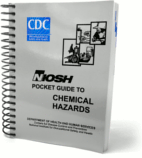
$22.00
The NIOSH Pocket Guide to Chemical Hazards presents key information and data in abbreviated or tabular form for chemicals or substance groupings (e.g. cyanides, fluorides, manganese compounds) commonly found in the work environment. With this handy book you'll find information on recommended exposure limits, permissible exposure limits, chemical and physical properties, health hazards and personal protection for 677 chemicals regulated at the federal level.
- Most Current Printing/Revision Date.
- New layout for the Chemical Listing section, each chemical arranged in its own table.
- Expanded Chemical, Synonym and Trade Name Index.
- Conversion factors, Chemical Abstracts Service Registry Number and The Registry of Toxic Effects of Chemical Substances.
- Updated DOT ID and Guide Numbers to reflect changes made by DOT in the 2016 Emergency Response Guidebook.
- NIOSH Recommended Exposure Limits (NIOSH RELs).
- Occupational Safety and Health Administration Permissible Exposure Limits (OSHA PELs).
- NIOSH Immediate Dangerous to Life and Health values (NIOSH IDLHs).
- A physical description of the agent with chemical and physical properties.
- Measurement methods.
- Personal Protection and Sanitation Recommendations.
- Particulate respirator recommendations revised to include Part 84.
- Information on Health Hazards including: Route, Symptoms, First Aid and Target Organ information.
- Revised Appendix E to include OSHA respirator requirements for hazardous substances identified in the preamble to the OSHA Respiratory Protection Standard (29 CFR 1910.134).
Hazardous Material Compliance Pocketbook
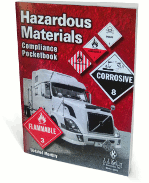
$6.50
This easy-to-read pocketbook gives your drivers fast access to the current regulatory information they need while hauling hazardous materials. And that can help reduce the chances of hazardous materials incidents resulting from human error.
Contains hazardous materials regulations as amended by HM-215G, the information your drivers need to stay in compliance.
Updated monthly, the pocketbook covers identifying hazmat shipments, placarding, loading and unloading, transport, and specific class requirements. Includes the §171.101 Hazardous Materials Table with a placard column to help drivers easily identify DOT-required placards, plus the List of Hazardous Substances, the List of Marine Pollutants, and special provsions.

